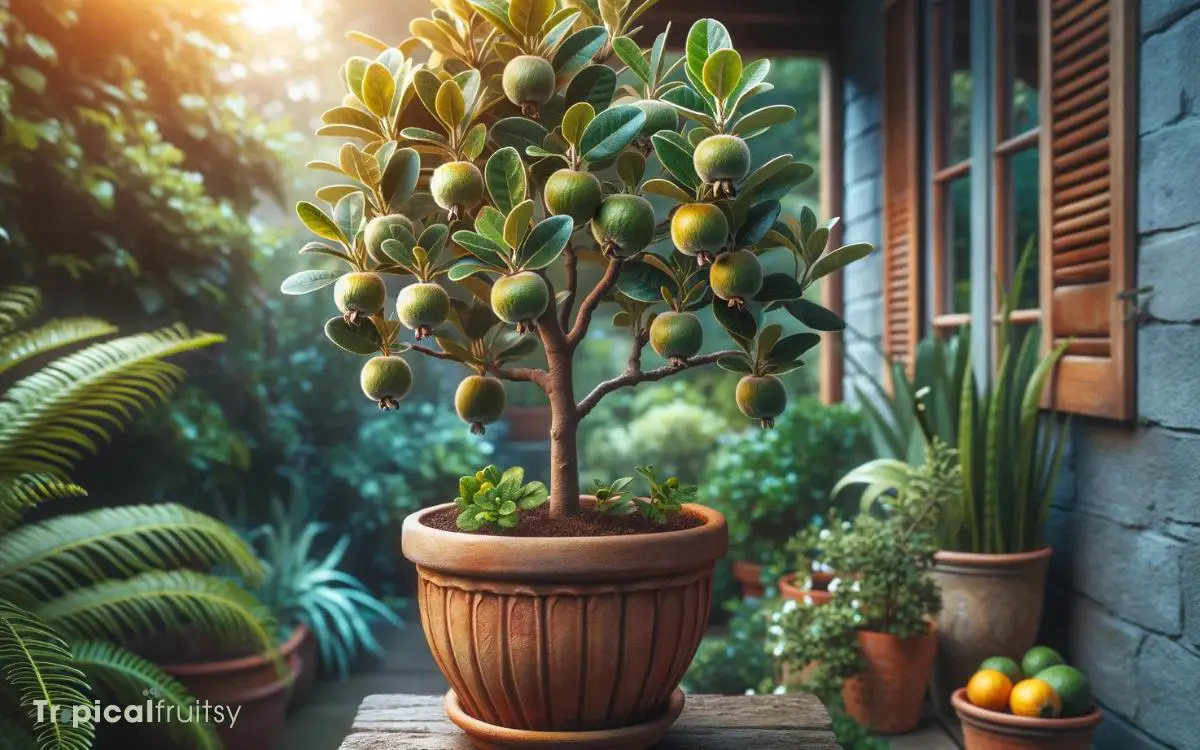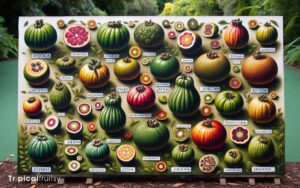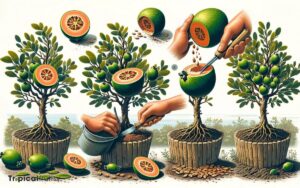Can You Grow Feijoa in a Pot? Revealing the Truth!
Gardeners in urban spaces often turn to container gardening, and it’s no surprise that one can indeed grow feijoa, or pineapple guava, in a pot.
This method accommodates those with limited ground space while still allowing them to enjoy the plant’s sweet fruit and attractive foliage.
The key to success lies in understanding feijoa’s needs: selecting a container large enough to support its growth, using well-draining soil, and ensuring it receives ample sunlight.
Regular pruning helps maintain a manageable size and promotes healthy fruiting. With the right care, even potted feijoa trees can thrive and produce a generous yield.
This introduction will guide enthusiasts through the essentials of cultivating feijoa in a pot.

Key Takeaway
Understanding Feijoa’s Requirements
Feijoas typically need well-draining soil and ample sunlight to thrive, even when potted. These subtropical plants demand at least six hours of direct sunlight daily to ensure optimal growth and fruit production.
It’s crucial to select a potting mix rich in organic matter yet with sufficient perlite or sand to facilitate proper drainage.
Overly saturated roots can lead to root rot, which severely compromises the plant’s health. The container’s size matters as well;
it must accommodate the feijoa’s root system while allowing for growth. Drainage holes are non-negotiable to prevent water accumulation.
While feijoas are somewhat drought-tolerant, consistent moisture levels are key, especially during the flowering and fruiting stages.
Regular watering, coupled with well-timed fertilization, supports their developmental needs.
Choosing the Right Pot
Selecting an appropriate container is a critical step in successfully growing feijoa in a pot, as it must provide enough space for root development and ensure adequate drainage.
Pot Material
- Terracotta: Breathable; offers a classic look that ages beautifully.
- Plastic: Lightweight; retains moisture longer, reducing watering frequency.
- Wood: Natural insulator; adds a rustic charm to your garden space.
Size Matters
- Depth: At least 12-18 inches to accommodate the root system.
- Diameter: Minimum of 18-24 inches, allowing growth without frequent repotting.
Drainage is Key
- Holes: Ensure multiple drainage holes at the bottom.
- Elevation: Consider pot feet or a raised platform to prevent waterlogging.
- Screening: Use mesh or broken pottery over holes to prevent soil loss.
Suitable Soil and Fertilizer
Feijoas require a well-draining soil mix, rich in organic matter, to thrive in a pot. They benefit from balanced fertilizers, with a focus on nitrogen, phosphorus, and potassium, to support their growth and fruit production.
The soil’s pH level should be slightly acidic to neutral, ideally between 5.5 and 7.0, for optimal nutrient uptake.
Optimal Soil Mix
One must ensure their potted feijoa has a well-draining soil mix enriched with balanced fertilizer for optimal growth.
For the feijoa aficionado, the soil’s composition isn’t merely a medium but a foundation that sustains life and vitality.
Soil Composition:
- Aeration: Perlite or pumice ensures the roots breathe, preventing root rot.
- Nutrition: Incorporate compost or a slow-release, balanced N-P-K fertilizer to nourish steadily.
- Acidity: Feijoas prefer slightly acidic soil; aim for a pH between 5.5 and 7.
The perfect soil mix is a symphony of elements, each playing a crucial role, harmonizing to create a haven where feijoas can thrive. It’s the gardener’s alchemy, turning the ordinary into a bountiful green treasure.
Fertilizer Types
To ensure robust growth and fruiting in potted feijoas, gardeners must choose between organic and synthetic fertilizers, each with its own advantages for the plant’s nutritional needs.
Organic options like compost or manure gradually enrich the soil, enhancing microbial activity essential for root health.
Synthetic fertilizers, however, offer precise nutrient ratios typically high in potassium and nitrogen, crucial for feijoa’s development and fruit production.
It’s imperative to use a well-balanced, slow-release fertilizer formulated for fruiting plants, applied according to the manufacturer’s instructions.
Over-fertilization can lead to salt accumulation, which negatively affects feijoa plants.
With the right fertilizer, feijoas can thrive even within the confines of a pot.
Ensuring the soil’s pH level is compatible with feijoa’s requirements is the next critical step.
Ph Level Requirements
Addressing the pH level requirements, gardeners should aim for slightly acidic to neutral soil, ideally with a pH between 5.5 and 7, to optimize feijoa growth and fruit production in pots.
To maintain this pH balance:
- Regularly test soil pH using a reliable kit or meter.
- Joy in nurturing: Experience the satisfaction of adjusting soil conditions for a thriving feijoa.
- Anticipation of blossoms: Anticipate the vibrant flowers as a sign of correct pH balance.
- Pride in harvest: Look forward to a bountiful feijoa harvest as a reward for diligence.
When the pH strays from the ideal range, use appropriate soil amendments. For acidic adjustments, elemental sulfur can be effective, while dolomite lime can raise the pH if it becomes too acidic.
Select fertilizers that complement the soil’s pH level, ensuring they don’t contribute to imbalance.
Planting Your Feijoa Tree
Planting a feijoa tree in a pot requires selecting the appropriate soil and container for optimal growth.
One must choose a container that’s large enough to accommodate the tree’s root system, with ample drainage holes to prevent waterlogging. The ideal vessel is usually a ceramic or plastic pot that’s at least 18-24 inches in diameter.
The soil should be well-draining and fertile, with a mix of peat, compost, and perlite or vermiculite to enhance aeration and moisture retention.
It’s crucial to position the tree at the same depth it was in its nursery container to avoid burying the stem too deeply, which can lead to rot.
After planting, water the feijoa thoroughly, ensuring the soil settles around the roots without leaving air pockets.
Watering and Drainage Tips
While feijoas are relatively drought-tolerant, they’ll thrive when watered consistently, ensuring the pot’s drainage system prevents root rot.
Here are some detailed tips:
Watering Schedule:
- Adjust frequency based on season; more in summer, less in winter.
- Check the top inch of soil; water when it feels dry.
- Offer a deep watering to encourage strong root growth.
Drainage Essentials:
- Use pots with ample drainage holes.
- Layer the bottom with gravel or broken terracotta to prevent clogging.
- Ensure water flows freely out the bottom to avoid waterlogging.
Monitoring Moisture:
- Invest in a moisture meter for accuracy.
- Look for signs of over-watering, like yellowing leaves.
- Allow the soil to dry out slightly between watering sessions.
As the feijoa’s roots establish, they’ll require regular pruning and maintenance for optimal growth.
Pruning and Maintenance
Following the establishment of a consistent watering routine, regular pruning is essential to maintain the feijoa’s shape and encourage fruitful growth. Pruning should occur in the late winter or early spring before the new growth starts.
Gardeners must remove any dead or diseased branches to prevent the spread of disease and to improve air circulation within the canopy.
Thinning out the center of the plant allows sunlight to penetrate, vital for fruit development. Moreover, trimming back the tips of branches can stimulate the growth of new fruiting wood.
Careful attention to cutting at a 45-degree angle above a bud facing the desired direction of growth ensures a well-shaped plant.
As the pruning session concludes, gardeners then prepare for the next critical phase: overwintering and repotting.
Overwintering and Repotting
To ensure your potted feijoa thrives, it’s crucial to manage overwintering and repotting with care. Overwintering requires a delicate balance to protect the plant from cold stress while maintaining adequate dormancy.
Overwintering:
- Insulate: Wrap pots in bubble wrap or burlap to shield roots from freezing temperatures.
- Location: Move plants to a sheltered area, like a garage or basement, where they’re safe from frost but cool enough to remain dormant.
- Watering: Reduce watering to prevent root rot, yet keep the soil slightly moist.
Repotting should be done with precision to encourage healthy growth and fruit production.
Repotting:
- Timing: Every 2-3 years in early spring, before new growth starts.
- Soil: Use high-quality potting mix rich in organic matter.
- Pot size: Increase pot size gradually to prevent shock and ensure stability.
Conclusion
Growing feijoa in a pot is indeed feasible with the right conditions. Ensure the container is spacious and has excellent drainage. Use a nutrient-rich soil blend and fertilize regularly.
Although one might argue that feijoa trees are too large for pots, dwarf varieties thrive in container environments when pruned properly.
With attentive watering, seasonal pruning, and periodic repotting, your potted feijoa can flourish, offering a practical solution for space-limited gardeners eager to enjoy this unique fruit.





